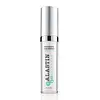What's inside
What's inside
 Key Ingredients
Key Ingredients

 Benefits
Benefits

 Concerns
Concerns

 Ingredients Side-by-side
Ingredients Side-by-side

Water
Skin ConditioningPrunus Amygdalus Dulcis Oil
Skin ConditioningCaprylic/Capric Triglyceride
MaskingStearic Acid
CleansingPEG-12 Glyceryl Dimyristate
Skin ConditioningGlyceryl Stearate
EmollientPEG-100 Stearate
Silica
AbrasiveTocopheryl Acetate
AntioxidantCetyl Alcohol
EmollientPhenoxyethanol
PreservativeTriethanolamine
BufferingCarbomer
Emulsion StabilisingPanthenol
Skin ConditioningEthoxydiglycol
HumectantPolyaminopropyl Biguanide
PreservativeDisodium EDTA
PPG-12/Smdi Copolymer
EmollientKinetin
Skin ConditioningZeatin
Skin ConditioningPolyurethane-40
Ethylhexylglycerin
Skin ConditioningCitrus Aurantium Dulcis Peel Oil
MaskingCaprylyl Glycol
EmollientSodium Carboxymethyl Betaglucan
Tetrahexyldecyl Ascorbate
AntioxidantAcetyl Octapeptide-3
HumectantImidazolidinyl Urea
PreservativeSodium Hyaluronate
HumectantCamellia Sinensis Leaf Extract
AntimicrobialHydrochloric Acid
BufferingWater, Prunus Amygdalus Dulcis Oil, Caprylic/Capric Triglyceride, Stearic Acid, PEG-12 Glyceryl Dimyristate, Glyceryl Stearate, PEG-100 Stearate, Silica, Tocopheryl Acetate, Cetyl Alcohol, Phenoxyethanol, Triethanolamine, Carbomer, Panthenol, Ethoxydiglycol, Polyaminopropyl Biguanide, Disodium EDTA, PPG-12/Smdi Copolymer, Kinetin, Zeatin, Polyurethane-40, Ethylhexylglycerin, Citrus Aurantium Dulcis Peel Oil, Caprylyl Glycol, Sodium Carboxymethyl Betaglucan, Tetrahexyldecyl Ascorbate, Acetyl Octapeptide-3, Imidazolidinyl Urea, Sodium Hyaluronate, Camellia Sinensis Leaf Extract, Hydrochloric Acid
Water
Skin ConditioningGlycerin
HumectantPropanediol
SolventNiacinamide
SmoothingIsopropyl Palmitate
EmollientPolyacrylate-13
Butylene Glycol
HumectantPalmitoyl Hexapeptide-12
Skin ConditioningPalmitoyl Tripeptide-1
Skin ConditioningPalmitoyl Tripeptide-5
Skin ConditioningPalmitoyl Dipeptide-5 Diaminobutyroyl Hydroxythreonine
Skin ConditioningPalmitoyl Dipeptide-5 Diaminohydroxybutyrate
Skin ConditioningAcetyl Hexapeptide-38
Skin ConditioningAscorbyl Palmitate
AntioxidantSwertia Chirata Extract
HumectantHydrolyzed Pea Protein
EmollientOrnithine
Skin ConditioningCeramide NP
Skin ConditioningErgothioneine
AntioxidantDunaliella Salina Extract
Skin ConditioningPhytosterols
Skin ConditioningPhospholipids
Skin ConditioningGlycolipids
Skin ConditioningTremella Fuciformis Sporocarp Extract
AntioxidantOlea Europaea Fruit Oil
MaskingGlycine Soja Oil
EmollientButyrospermum Parkii Butter
Skin ConditioningBetaine
HumectantSqualane
EmollientLecithin
EmollientCaprylyl Methicone
Skin ConditioningDisodium EDTA
Polysorbate 20
EmulsifyingTocopherol
AntioxidantCaprylyl Glycol
EmollientCaprylhydroxamic Acid
Polyisobutene
Potassium Sorbate
PreservativeLevulinic Acid
PerfumingSodium Hydroxide
BufferingHelianthus Annuus Seed Oil
EmollientP-Anisic Acid
MaskingSorbitan Isostearate
EmulsifyingEthylhexylglycerin
Skin ConditioningPhenoxyethanol
PreservativeWater, Glycerin, Propanediol, Niacinamide, Isopropyl Palmitate, Polyacrylate-13, Butylene Glycol, Palmitoyl Hexapeptide-12, Palmitoyl Tripeptide-1, Palmitoyl Tripeptide-5, Palmitoyl Dipeptide-5 Diaminobutyroyl Hydroxythreonine, Palmitoyl Dipeptide-5 Diaminohydroxybutyrate, Acetyl Hexapeptide-38, Ascorbyl Palmitate, Swertia Chirata Extract, Hydrolyzed Pea Protein, Ornithine, Ceramide NP, Ergothioneine, Dunaliella Salina Extract, Phytosterols, Phospholipids, Glycolipids, Tremella Fuciformis Sporocarp Extract, Olea Europaea Fruit Oil, Glycine Soja Oil, Butyrospermum Parkii Butter, Betaine, Squalane, Lecithin, Caprylyl Methicone, Disodium EDTA, Polysorbate 20, Tocopherol, Caprylyl Glycol, Caprylhydroxamic Acid, Polyisobutene, Potassium Sorbate, Levulinic Acid, Sodium Hydroxide, Helianthus Annuus Seed Oil, P-Anisic Acid, Sorbitan Isostearate, Ethylhexylglycerin, Phenoxyethanol
Ingredients Explained
These ingredients are found in both products.
Ingredients higher up in an ingredient list are typically present in a larger amount.
Caprylyl Glycol is a humectant and emollient, meaning it attracts and preserves moisture.
It is a common ingredient in many products, especially those designed to hydrate skin. The primary benefits are retaining moisture, skin softening, and promoting a healthy skin barrier.
Though Caprylyl Glycol is an alcohol derived from fatty acids, it is not the kind that can dry out skin.
This ingredient is also used as a preservative to extend the life of products. It has slight antimicrobial properties.
Learn more about Caprylyl GlycolDisodium EDTA plays a role in making products more stable by aiding other preservatives.
It is a chelating agent, meaning it neutralizes metal ions that may be found in a product.
Disodium EDTA is a salt of edetic acid and is found to be safe in cosmetic ingredients.
Learn more about Disodium EDTAEthylhexylglycerin (we can't pronounce this either) is commonly used as a preservative and skin softener. It is derived from glyceryl.
You might see Ethylhexylglycerin often paired with other preservatives such as phenoxyethanol. Ethylhexylglycerin has been found to increase the effectiveness of these other preservatives.
Phenoxyethanol is a preservative that has germicide, antimicrobial, and aromatic properties. Studies show that phenoxyethanol can prevent microbial growth. By itself, it has a scent that is similar to that of a rose.
It's often used in formulations along with Caprylyl Glycol to preserve the shelf life of products.
Water. It's the most common cosmetic ingredient of all. You'll usually see it at the top of ingredient lists, meaning that it makes up the largest part of the product.
So why is it so popular? Water most often acts as a solvent - this means that it helps dissolve other ingredients into the formulation.
You'll also recognize water as that liquid we all need to stay alive. If you see this, drink a glass of water. Stay hydrated!
Learn more about Water